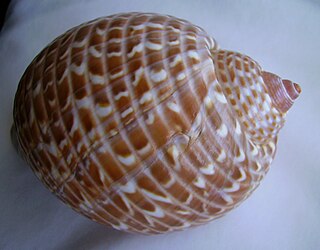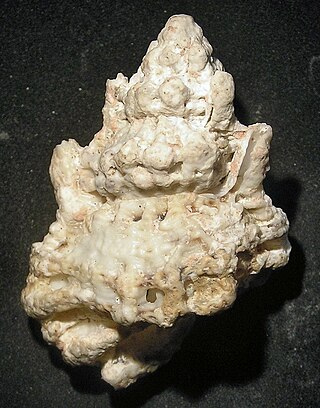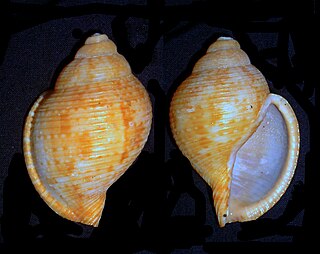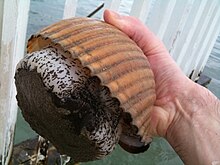
The Tonnidae are a family of medium-sized to very large sea snails, known as the tun shells. These are marine gastropod molluscs in the clade Littorinimorpha. The name tun refers to the snails' shell shape, which resembles wine casks known as "tuns". While thin, the shells are also strong and lack opercula. They are found in all tropical seas, where they inhabit sandy areas. During the day, they bury themselves in the substrate, emerging at night to feed on echinoderms, crustaceans, and bivalves. Some larger species also capture fish, using their expandable probosces to swallow them whole. Females lay rows of eggs that become free-swimming larvae for several months before settling to the bottom.

Scutus is a genus of large sea snails or limpets with the common name "shield shells". These are marine gastropod molluscs in the family Fissurellidae, the keyhole limpets and slit limpets.

Buccinum is a genus of medium-sized sea snails, marine gastropod molluscs in the family Buccinidae, the true whelks.

Thais, sometimes known by the common names dog winkles or rock shells, is a genus of medium to large predatory sea snails with an operculum, marine gastropod molluscs in the family Muricidae.

Tonna cumingi, common name Cuming's tun, is a species of very large sea snail, a tun snail, a marine gastropod mollusc in the family Tonnidae, the tuns.

Tonna dolium, common name the spotted tun, is a species of large sea snail or tun snail, a marine gastropod mollusc in the family Tonnidae, the tun shells.

Tonna galea, commonly known as the giant tun, is a species of marine gastropod mollusc in the family Tonnidae. This very large sea snail or tun snail is found in the North Atlantic Ocean as far as the coast of West Africa, in the Mediterranean Sea and the Caribbean Sea. The species was first described by Carl Linnaeus in 1758.

Tonna perdix, common name the partridge tun, is a species of very large sea snail, a marine gastropod mollusc in the family Tonnidae, the tun shells.

Bursa is a genus of large sea snails, marine gastropod molluscs in the family Bursidae, the frog snails or frog shells.

Spisula is a genus of medium-sized to large marine bivalve mollusks or clams in the subfamily Mactrinae of the family Mactridae, commonly known as surf clams or trough shells.

Purpura is a genus of sea snails, marine gastropod mollusks in the subfamily Rapaninae of the family Muricidae, the murex snails or rock snails.

Tonna allium, common name the costate tun, is a species of large sea snail, a marine gastropod mollusk in the family Tonnidae, the tun shells.

Tonna boucheti is a species of large sea snail, a marine gastropod mollusk in the family Tonnidae, the tun shells.

Tonna dunkeri is a species of large sea snail, a marine gastropod mollusk in the family Tonnidae, the tun shells.

Tonna lischkeana is a species of large sea snail, a marine gastropod mollusk in the family Tonnidae, the tun shells.

Tonna sulcosa, common name banded tun, is a species of large sea snail, a marine gastropod mollusk in the family Tonnidae, the tun shells.

Tonna tessellata, the mosaic tun, tessellate tun or maculated tun, is a species of large sea snail, a marine gastropod mollusk in the family Tonnidae.

Malea is a genus of large sea snails, marine gastropod mollusks in the family Tonnidae, the tun shells.

Tonna chinensis, common name : the China tun, is a species of large sea snail, a marine gastropod mollusk in the family Tonnidae, the tun shells.

Tonna variegata, commonly known as the variegated tun, is a species of marine gastropod mollusc in the family Tonnidae.




















